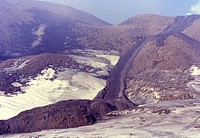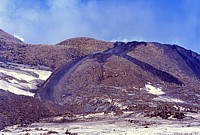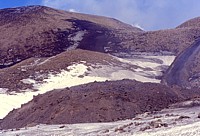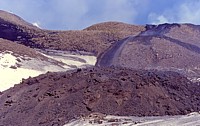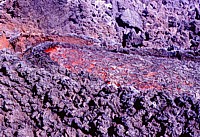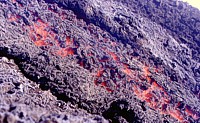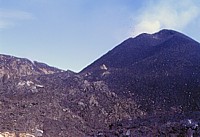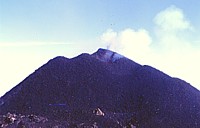The
dance of the lava, February 1999
When
February 1999 began, the Southeast Crater had not erupted since
more than a week - while previously, paroxysmal eruptive episodes
had occurred every few days. On the afternoon of 4 February, however,
the crater once more reawakened, and for the first half-hour of
this new paroxysm things went pretty much the same way as during
the previous events of this kind. But then white steam began to
issue from a place about halfway down on the southeast flank of
the cone of the Southeast Crater, and soon thereafter, a lava
fountain burst through the flank in the same spot. This fountain
continued for some 30 minutes and then died out, but a new fissure
opened at the base of the cone, from which a lava flow began to
extend into the direction of the Valle del Bove rim.
Two days later, this time with Giuseppe Scarpinati, I was at the
site of this new activity, which was continuing with the emission
of significant lava flows and minor spattering. Lava issued from
numerous vents, and rhythmic degassing produced a peculiar phenomenon
in which the lava appeared to be "dancing", or "breathing",
within the vent. This eruption continued for more than 9 months,
and during this period Etna was visited by more tourists than
ever before (and ever after).
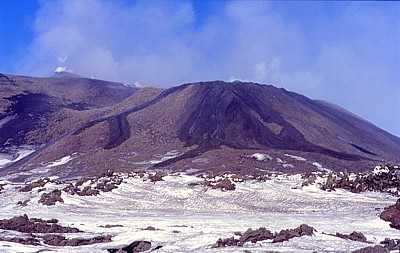
|
View
of the southern flank of the Southeast Crater cone on 8
January 1998. The cone is low and broad, truncated by a
150 m-diameter crater at its top, and a small intracrater
cone (whose top is barely visible above the crest of the
crater rim) is growing on its floor. Lava issuing from vents
at the base of the intracrater cone has overflowed the crater
rim in many places since mid-July 1997, forming the dark
lobes visible in this image. Nearly all of these overflows
stopped once they reached the base of the Southeast Crater
cone. However, in early January 1998, a somewhat longer
flow (at the extreme left of this photograph, and seen in
more detail in the images below; see also the archived January
1998 Etna News) advanced about 150 m beyond the base
of the cone |
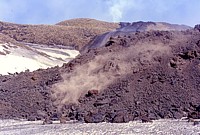 |
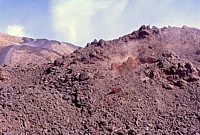
|
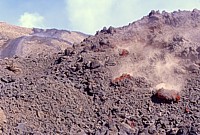 |
Advancing
front of the lava flow shown in the previous photographs.
The flow is advancing at a speed of a few meters per hour,
with blocks cascading down the steep face of the front.
Sometimes, larger portions of the front collapse (left image),
exposing the incandescent interior of the flow (center image),
from which glowing blocks continue to detach (central and
right images). This is, in really slow-motion, the classical
mode of advance of Etnean 'a'a lava flows |
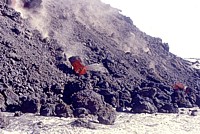 |
Fire
and ice: incandescent blocks of lava cascading down the
advancing flow front eventually end up on the surface of
the snow that covers the summit area. There is remarkably
little interaction between the hot rock and the snow during
the observations made on that day, possibly due to the extremely
slow advance of the flow front |
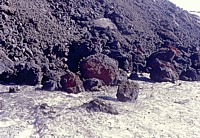 |
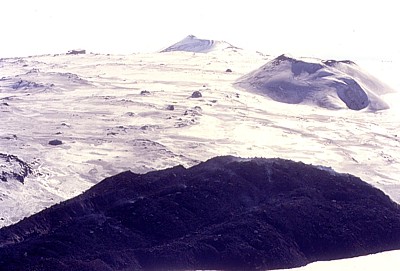
|
| A
black, stony paw of lava reaches out into the white snow:
this is the frontal portion of the lava flow seen in the
previous photographs, as it appeared when viewed from halfway
up the slope of Etna's central summit cone. The cone standing
in the right part of the image is the "Observatory
cone" formed during the first phase of the 1971 eruption.
Peak in the background is the Montagnola, site of a 1763
flank eruption. The building to the left of the Montagnola
is the Torre del Filosofo mountain hut |
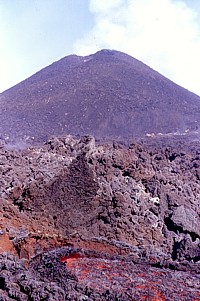 |
Once
arrived on the southwestern rim of the Southeast Crater,
the growing intracrater cone becomes visible in its full
size (a few tens of meters above the surrounding lava field).
The source of the lava flow shown in the previous images
can be seen in the foreground of the photograph at left.
This effusive vent lies at a distance of about 70 m from
the intracrater cone and probably marks the end of a lava
tube (such effusive vents, which lie away from the places
where magma rises to the surface, are called "ephemeral
vents"). Right photograph shows a small Strombolian
explosion at the summit vent of the intracrater cone |
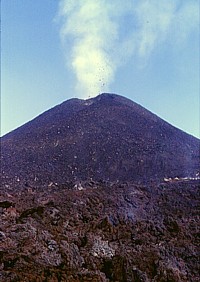 |
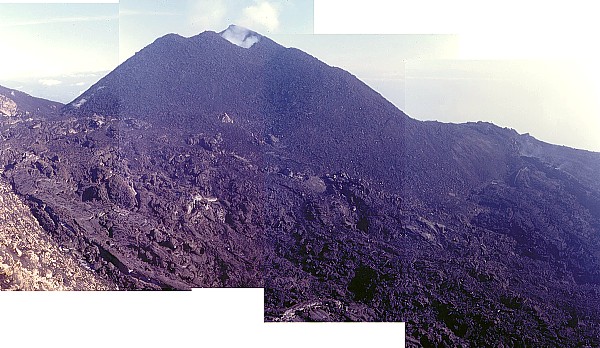
|
Photomosaic
showing the intracrater cone of the Southeast Crater and
part of the surrounding lava field on 8 January 1998. To
better explain this image: one year before, the same place
was a depression a few tens of meters deep - the Southeast
Crater proper - and the intracrater cone was but
a very small heap of scoriae (see March 1997 photo at the
Global
Volcanism Network, taken by A. Amantia of the Istituto
Internazionale di Vulcanologia, now INGV Catania). Much
of the crater has since been filled by the products of the
ceaseless Strombolian and effusive activity, significantly
increasing the size of the intracrater cone, and continuously
raising the level of the surrounding lava field. As of January
1998, the former rim of the Southeast Crater has been buried
in many places by lava overflows, especially on the southern
and eastern sides (to the right of the area visible here).
However, the high western portion of the rim is still visible
at the extreme left. Photos were taken from the southwestern
rim of the Southeast Crater |
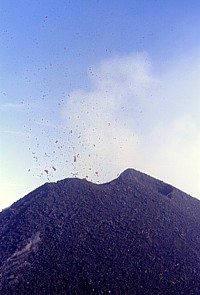 |
Two
further views of the Strombolian activity alternating between
the two vents at the summit of the intracrater cone of the
Southeast Crater on 8 January 1998, photographed from the
slope of the central summit cone above the Southeast Crater.
Activity would persist at one of the two vents for about
one hour and then shift to the other. Interestingly, explosions
at the northern vent (left image) were accompanied by little
noise, while those at the southern vent (right image) produced
loud bangs |
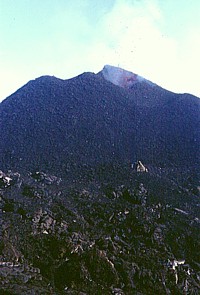 |
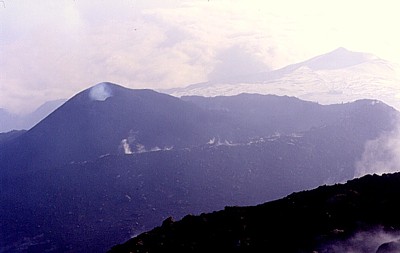
|
| This
is a view from the southeastern rim of the former Central
Crater (of which only a platform remains in its southeastern
portion, the remainder being occupied by the Bocca Nuova
in the southwest and the Voragine in the north) toward the
Southeast Crater, whose intracrater cone is visible emitting
a gas plume at left. Wisps of white vapor are also rising
from the western rim of the Southeast Crater, seen in front
of the intracrater cone. The Montagnola is visible in the
distance at right. Photograph taken on 8 January 1998 |
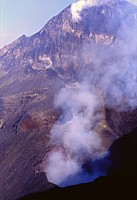 |
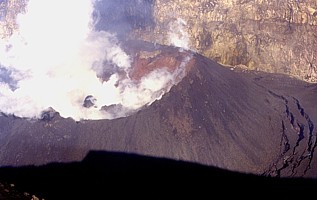 |
The
Bocca Nuova in ominous silence, 8 January 1998. Left photograph
shows the southeastern vent area (seen from south) with
two circular pits, the more southerly is emitting a bluish
gas plume. A pyroclastic half-cone, leaning against the
inner southeastern crater wall, has built up considerably
since early November 1997, the time of my previous visit.
The right photograph shows the partially collapsed cone
at the northwestern vent area (seen from west), which two
months earlier had stood only 50 m below the rim of the
Bocca Nuova. Collapse is not only affecting the summit portion
of the cone, but the whole vent area is subsiding, as is
plainly visible from the spectacular arcuate faults at the
cone's base at right |
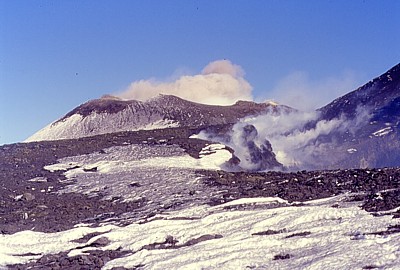
|
A
light brown ash plume is rising from the Northeast Crater,
seen in this photograph from the northwestern rim of the
Bocca Nuova on 8 January 1998. Like the Bocca Nuova, also
the Northeast Crater was affected by internal collapse during
the seismic crises of late 1997 and early 1998 |
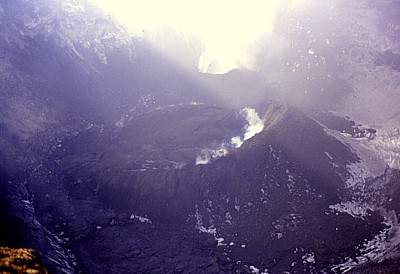
|
Lying
largely in the shadow, the intracrater cone on the bottom
of the Voragine is completely inactive, with a few wisps
of vapor issuing from its southern rim. The cone is much
larger than it was when I last saw it in early October 1997
(a brief November 1997 visit had not permitted to see any
details of the cone's size). A more substantial gas plume
is seen rising from the southwestern pit of the Voragine,
in the background. This pit, which has opened at the base
of the thin septum separating the Voragine from the Bocca
Nuova (locally known as "diaframma"), was observed
during this visit (8 January 1998) to dive obliquely in
the direction of the Bocca Nuova, and therefore seems to
be related to that crater rather than to the Voragine |
|
![]()


